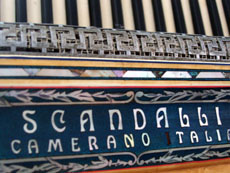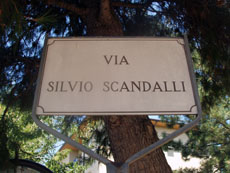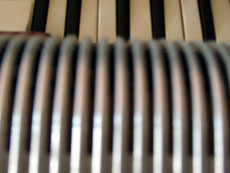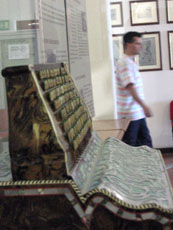| "Shepherd
farmer son" continues...
The
success of their Scandalli Brothers factory grew, and by
1946, the Scandallis joined forces with Soprani and an accordion-maker
from Numana to form Farfisa. The factory became one of the
world’s largest musical instrument factories.
Among his innovations, Scandalli’s
greatest accomplishment was probably the invention of the
Scandalli Super VI, devised with the help of Farfisa’s
finest technicians in 1951.
“The Super VI inspires
every modern accordion producer to imitate its sound. Yet
no one has been able to. It is the best accordion in the
world. It is like a piece of art,” says Sandro Strologo,
who has written about the regional accordion industry and
about Scandalli. |

A Scandalli accordion from Camerano, on display
in the City Hall, July 13, 2006. Photograph by Cassie
Echer |
By the 1960s,
Farfisa had branched into the production of guitars, pianos,
electric organs and electric accordions. Eventually, an
American company, Lear Siegler, assumed control but had
trouble meeting Japanese competition. The company was also
in need of financial assistance, but the local banks were
reportedly unwilling to help. |
The crisis led to the breakup of Farfisa and Scandalli’s
separation from the companies.
Scandalli was a “great lover of work and music,”
who wanted the best from his accordion music, Strologo says.
This “simple, self-made, hard-working man,”
as Strologo calls him, developed good relationships with
employees and tried to help solve their problems. |
|
He
was so involved in his work that he walked around the factory
at night to make sure everything was in place, and sometimes
gave tests to his employees to make sure their performance
was the best.
He served as mayor, or podesta, of Camerano for a time
in the 1930s, during the Fascist period, and gave money
for construction of a new steeple on the San Francesco Church.
|

Via Silvio Scandalli street sign in Camerano,
Italy, July 18, 2006. Photograph by Cassie Echer.
|
| He was so appreciated for his contributions
to Camerano that the town awarded him a plaque, now hanging
in the San Francesco church. A collection of Scandalli accordions
is also on display in Town Hall, and the town hopes to extend
the collection.
Scandalli married twice, to two sisters: first, to Maria
Perugini, and after her death in 1960, to her sister Elvira.
Although he never had children of his own, he adopted his
sister’s daughter, Silvana to be able to help her
financially.
Scandalli at one point in his career had moved to Ancona
but always maintained a second home in Camerano. He died
in 1977 at the age of 88.
When asked how long Scandalli’s legacy would endure,
Strologo replied, “As long as accordions will be produced,
Scandalli will be remembered. Many other manufacturers will
be forgotten, but not Scandalli. No one else could do the
same with a single instrument.” |
|
Scandalli accordions on display in
Camerano's City Hall, July 13, 2006. Photograph by Cassie Echer.

|





